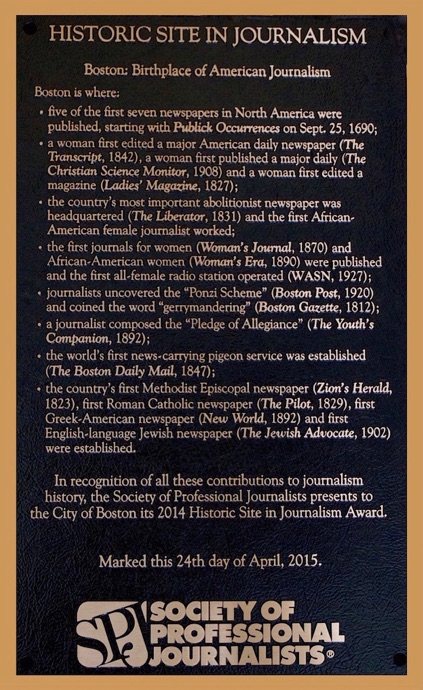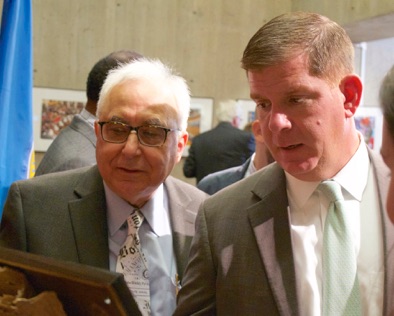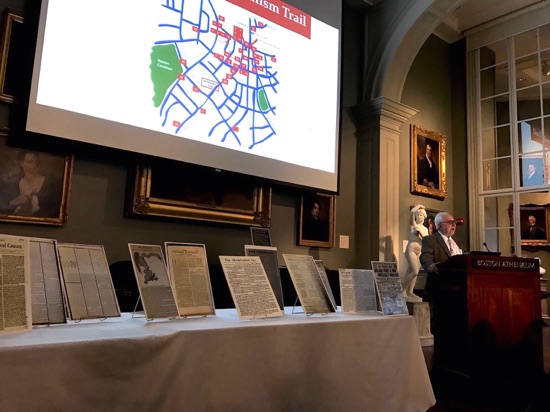Boston: Birthplace
of American Journalism
✶ The first three, and five of the first seven newspapers in North America, were published in Boston: Publick Occurrences, 1690; The Boston News-Letter, 1704-1776; The Boston Gazette, 1719-1831; New England Courant, 1721-1726; New England Weekly Journal, 1727-1741 (see #1 through #5 on the map).
✶ Boston Post reporters uncovered Carlo Ponzi’s financial scheme (see #21), Boston Gazette editors coined the word “gerrymandering” (see #3), the Boston Post was the first to print the acronym “O.K.” (see #21) and the first full-page newspaper advertisement appeared in The Boston Globe (see #26).
✶ The most important abolitionist paper in the country, The Liberator, was published in Boston (see #22).
✶ J. Daniel Craig of The Boston Daily Mail (see #38) sent news dispatches to his paper using carrier pigeons in 1847, at least a year before Paul Reuter started his legendary Aachen-Brussels pigeon service. Craig would go to Halifax, N.S., read the newly arrived European newspapers and send summaries to Boston via his own pigeons, beating the competition by several hours.
✶ Of the 14 journalists who were indicted under the 1798 Sedition Act, five were from Boston (see #12, #37, “Other Boston Firsts”).
✶ Women played an immense role in Boston journalism. Boston had the first female daily newspaper editor (see #20), Cornelia Wells Walter of The Boston Evening Transcript, the first female publisher of a major daily, Mary Baker Eddy of The Christian Science Monitor (see “Other Boston Firsts”), the first African-American woman journalist, Maria W. Stewart of The Liberator (see #22 and “Other Boston Firsts”), and the first female magazine editor, Sarah Josepha Hale of Boston’s Ladies’ Magazine (see “Other Boston Firsts”).
✶ Boston’s The Woman’s Journal (see #25) was the first national newspaper to be staffed by and aim solely at women. The Una, the first U.S. newspaper dedicated to solely covering women’s rights, was published in Boston, as was The Remonstrance, the first anti-suffrage American periodical (see “Other Boston Firsts”). The first female foreign correspondent, Margaret Fuller of Horace Greeley’s New York Tribune, started her career in Boston by editing the Transcendentalist journal The Dial (see “Other Boston Firsts”). In 1885, the New England Woman’s Press Association was founded at the offices of the Boston Herald (see “Other Boston Firsts”).
✶ The first all-female radio station, WASN, was started in Boston (see #30), the first American commercial radio license was granted to Boston’s WBZ, and the country’s first 24-hour regional cable television news network, NECN, was started in Boston (see “Other Boston Firsts”). The first female African-American magazine publisher/editor was Boston’s Josephine St. Pierre Ruffin, founder of Woman’s Era (see “Other Boston Firsts”).
✶ Boston’s Youth’s Companion magazine (see “Other Boston Firsts”) was the first to publicize the “The Pledge of Allegiance,” which was composed in 1892 by Francis Bellamy, a Companion staff member, for a national school celebration of the 400th anniversary of Columbus’ discovery of America.
✶ The Boston Herald in 1942 was the first American newspaper to officially participate in the war effort by starting a “Rumor Clinic.” It consisted of a group of volunteers, under the guidance of local muckraker Frances Sweeney, and aimed at collecting and debunking Axis rumors, which were undermining public morale (see “Other Boston Firsts”).
✶ Finally, Boston was the birthplace of the first French language newspaper in America, Courier de Boston (1789) (see “Other Boston Firsts”); the first Methodist Episcopal newspaper, Zion’s Herald (1823)(see #35); the nation’s oldest Roman Catholic newspaper, The Pilot (1829)(see #19); the first Greek-American newspaper, New World (Νέος Κόσμος)(1892)(see “Other Boston Firsts”) and the first English-language Jewish newspaper, The Jewish Advocate (1902)(see #27).




